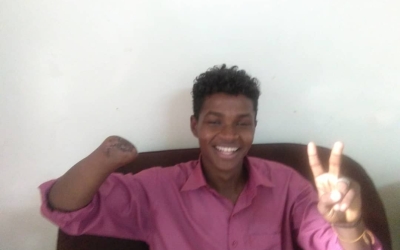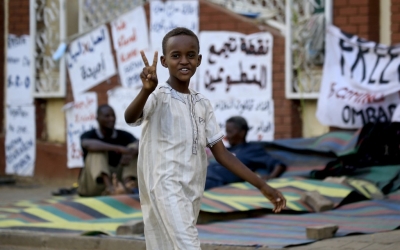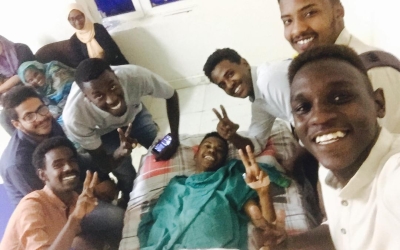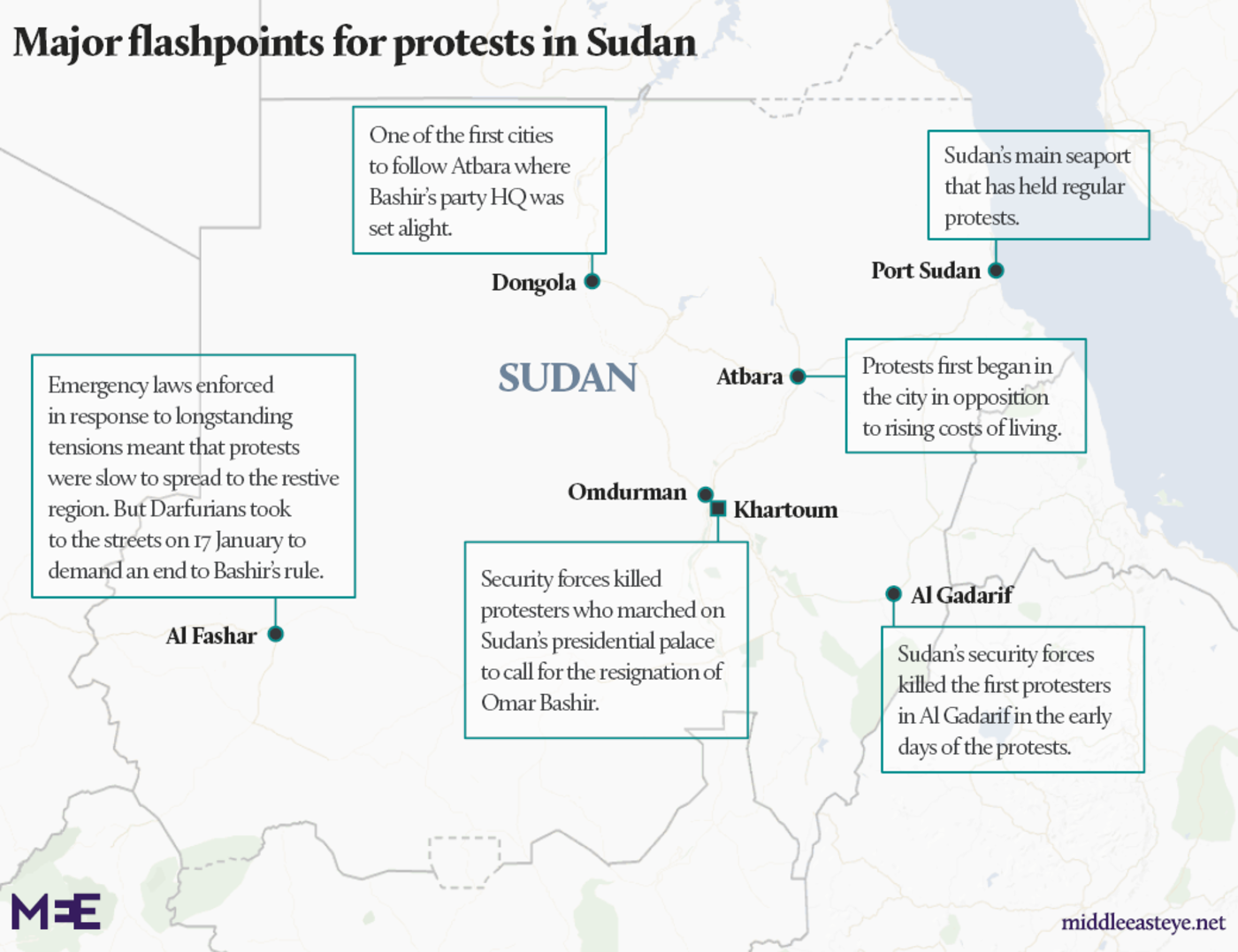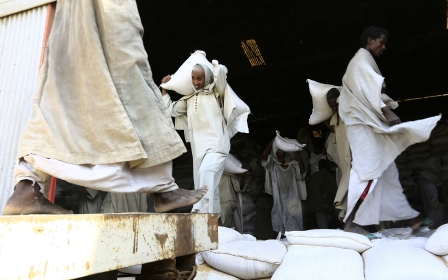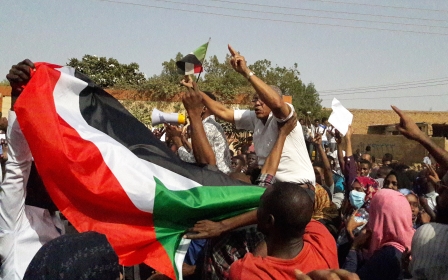Wounded Sudanese 'proud' of injuries sustained during protests

Mohamed Salih Adel looked down at the scar tissue where surgeons sealed his right arm at the wrist after removing the burnt remains of his hand.
“I will never look at it as any kind of disability in the future. I’m very proud of what has happened to me because it’s a sign that I responded to the call of my country,” said the 23-year-old student at the University of Khartoum.
Adel had been taking part in protests at the university against the Sudanese government in December when, he said, a stun grenade exploded next to him.
'We have taken to the streets to raise our voices as a new generation'
- Mohamed Salih Adel, student
“I don’t know what happened exactly, I heard a huge explosion. Suddenly there was blood everywhere around me and then I realised I had lost my hand,” he told Middle East Eye.
“It was hard in the beginning, but since they did the surgery a few days ago, I’m feeling fine now.”
After leaving hospital, Adel said he had returned to the ongoing protests and had no regrets about what had happened to him.
Nor he said, had he shifted in his opposition to the continuing rule of Sudanese President Omar al-Bashir.
“It’s not about me, I personally know many colleagues and friends who have had the same experience, because we have taken to the streets to defend our rights and raise our demands and voices as a new generation.”
A source at the Central Committee of Sudanese Doctors, speaking on condition of anonymity, told MEE there had been dozens of similar cases reported in which protesters had suffered life-changing injuries such as losing fingers or limbs, or being blinded.
According to government figures, at least 30 people have been killed and more than 400 injured in protests so far, while more than 800 people have been arrested. Human Rights Watch said on 1 February that at least 51 protesters had been shot dead.
Why are Sudanese protesting against their government?
+ Show - HideSudanese protests have evolved in the space of less than six months from complaints about bread prices to calls for long-term leader Omar al-Bashir to go and demands for a civilian-led transition to democracy.
Here's a summary of the key moments so far since the protests began.
19 December 2018: People take to the streets in the city of Atbara to protest against a government decision to triple the price of bread, torching a local ruling party office. By the next day protesters on the streets of Khartoum and other cities calling for "freedom, peace, justice". Police try to disperse the crowds, resulting in at least eight deaths. Dozens more will be killed in the weeks of protest that follow
22 February 2019: Sudanese President Omar al-Bashir declares a nationwide state of emergency. He swears in a new prime minister two days later, as riot police confront hundreds of protesters calling for him to resign
6 April: Thousands gather outside the army's headquarters in Khartoum, chanting "one army, one people" in a plea for the military's support. They defy attempts by state security forces to dislodge them and troops intervene to protect them
11 April: Military authorities announce they have removed Bashir and that a transitional military council will govern for two years. Despite celebrations at Bashir's demise, protest leaders denounce the move as a "coup" and the protesters remain camped outside army headquarters.
14 April: Protest leaders call on the military council to transfer power to a civilian government
20 April: Sudan's military rulers hold a first round of talks with protest leaders
27 April: The two sides agree to establish a joint civilian-military ruling council, but talks stall over differences in the composition of the council, with both sides demanding a a majority
15 May: With negotiators reported to be close to agreeing a three-year transition to civilian rule, military leaders suspend talks and insist protesters remove barricades outside the army's headquarters. Talks resume on 19 May but break down again on 20 May, with the opposition insistent that a civilian must head the transitional governing body
28 May: Thousands of workers begin a two-day strike to pressure the military rulers and call for civilian government
3 June: At least 35 people killed and hundreds injured, according to opposition-aligned doctors, as security forces firing live ammunition move to disperse the protest camp outside army headquarters
4 June: General Abdel Fattah al-Burhan, the head of the military council, announces that all previous agreements with protest leaders are scrapped and says elections will be held in nine months
After a lull in recent days following a crackdown against protesters in the capital, crowds returned to the streets of central Khartoum on Thursday to demonstrate over the detention of hundreds of people arrested since December, with police responding with tear gas.
Victory sign
Abu Bakr al-Fadlabi said he had lost three fingers on his right hand while taking part in protests at the University of Khartoum on 22 December.
He also said his injuries had been caused by a stun grenade which he said had exploded in his hand as he was picking it up to throw it back in the direction in which it had been fired from.
“After a few seconds I lost consciousness. Some of my colleagues took me to the nearest hospital,” he said.
When he arrived, doctors had initially refused to treat his injuries because of the presence of security forces inside the hospital, Fadlabi said, “but after some negotiations they agreed”.
Since then, Fadlabi said he had undergone three operations in a private hospital.
Lying on a hospital bed with his right hand bandaged, Fadlabi remains defiant, raising a victory sign with his left hand and urging frequent visitors to continue protesting against the government.
“What happened to me is nothing when you look at the numbers killed and the youth we have lost in this uprising,” he said.
“We will continue protesting until we take our rights.”
Hospital wedding
On 24 January, Salah Yousif made good on his marriage proposal to his fiancee, Aarifa, but with the ceremony and celebrations taking place in a room at a private hospital in Khartoum, rather than at the venue where they had planned their wedding.
The wedding was brought forward, friends of Yousif told MEE, because he needs to travel to Moscow for emergency surgery after losing an eye when he was hit by a live bullet during protests in Khartoum.
In another reported case, family members of a man in intensive care at a Khartoum hospital told MEE that he had been “brutally attacked” by security forces while participating in protests in his home city of Alnihud in West Kordofan state on 17 December.
Abdul Baatin Ibrahim, a school teacher, suffered serious injuries to his neck, head and back during the protest and remains in a critical condition, a relative told MEE.
He was originally treated at Al-Obied city public hospital in North Kordofan state before being moved to the capital.
Counselling and rehabilitation
Psychologist Sulema Ishag told MEE that many of those who had suffered life-changing injuries would require counselling as well as rehabilitative treatment for their physical wounds during their recovery.
But she added: “The support they have received from others involved in the protests and their status as heroes of the uprising could be really beneficial for them as well.”
Mohamed Ibrahim Abdullah, a legal expert, told MEE that those injured in the protests had a right to bring a case against any member of the police or security forces who had attacked them, and possibly against senior government officials as well.
The right to protest is guaranteed by the Sudanese constitution, Abdullah said.
“According to article 146 of the civil law any person can open a case with the attorney general against the person that you think shot at you,” he said.
“But responsibility here could extend from the officers on the ground to the senior ranks, including the interior minister.”
In circumstances in which protests are deemed to be illegal, the law allows the police only to disperse or arrest participants providing they exercise restraint in doing so, Abdullah added.
“Article 128 of the criminal law states that the police have the right to repress illegal protests using minimal force. They have no right to use live ammunition unless with permission from the general prosecutor accompanying the police on the ground, and even then its use is restricted to not causing death.”
The intervention of security forces and pro-government militias against protesters appeared to contravene Sudanese law, Abdullah said.
Editor's note: Some of the names in this story have been changed to protect the identities of the individuals concerned.
Middle East Eye propose une couverture et une analyse indépendantes et incomparables du Moyen-Orient, de l’Afrique du Nord et d’autres régions du monde. Pour en savoir plus sur la reprise de ce contenu et les frais qui s’appliquent, veuillez remplir ce formulaire [en anglais]. Pour en savoir plus sur MEE, cliquez ici [en anglais].


